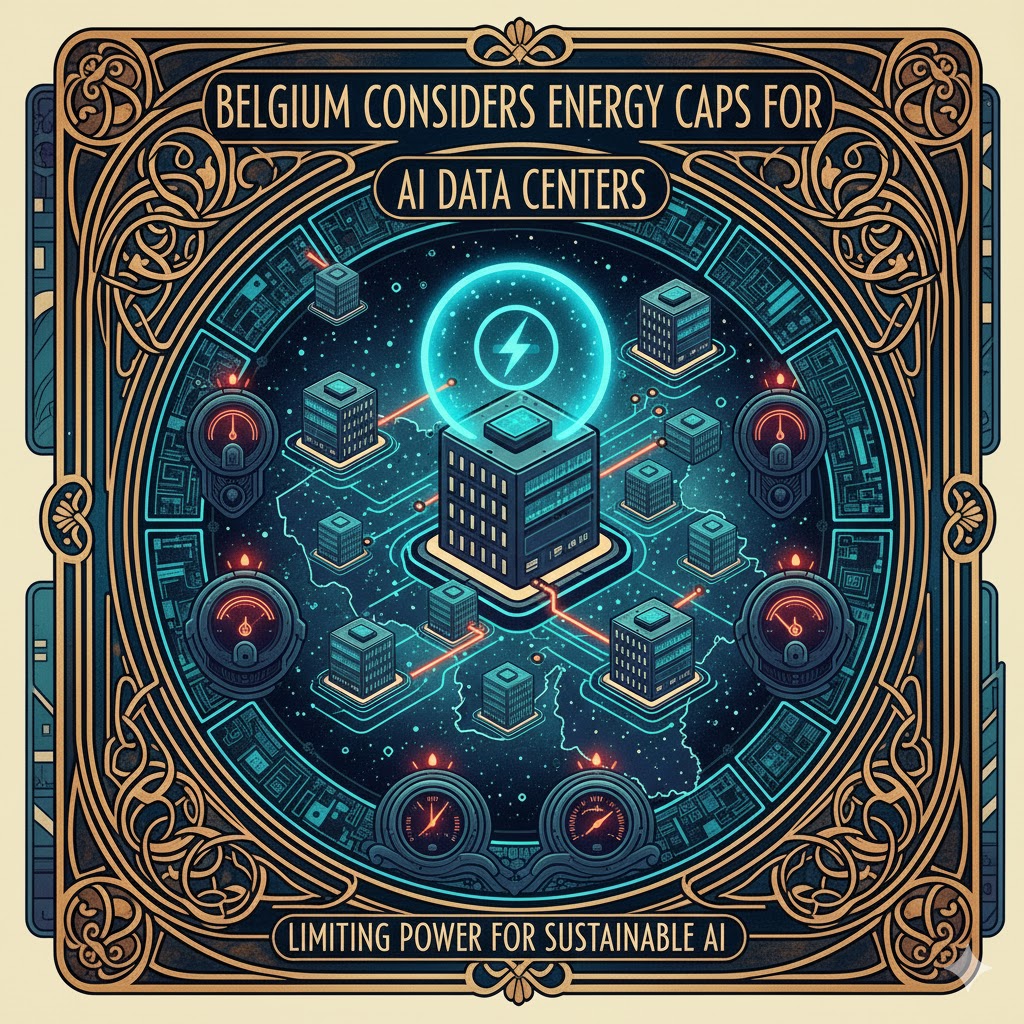Executive Summary
Belgium’s transmission system operator Elia has proposed classifying data centres as a distinct offtaker category with fixed grid-capacity allocations in its forthcoming 2028–2038 grid plan. The move responds to a nine-fold surge in connection requests since 2022, with reserved capacity for 2034 already overshooting prior scenarios. The goal: prevent speculative projects from crowding out other sectors and protect system adequacy while AI-driven compute demand accelerates. Reuters
Across Europe, regulators are converging on a common playbook: (1) planning controls and siting limits for hyperscale builds (Netherlands), (2) connection moratoria or conditional access in constrained hubs (Ireland/Dublin), and (3) mandatory transparency and performance reporting under the EU’s revised Energy Efficiency Directive (EED), with a broader EU package foreshadowed for 2026. White & Case+8DataCenterDynamics+8Cloud Computing News+8
Global context matters. The IEA projects data-centre electricity use could double to ~945 TWh by 2030, with AI the principal driver; alternative pathways remain possible if efficiency and workload management improve. These trajectories amplify near-term grid bottlenecks, siting conflicts, and sustainability trade-offs. IEA+1
What this white paper delivers: a decision framework for policymakers, grid operators, and builders to operationalize capacity allocations for data centres; comparative lessons from EU jurisdictions; scenario impacts to 2030; and an implementation roadmap with KPIs.
1) Background and Problem Statement
- Demand shock: Belgium’s grid has seen a step-change in connection requests from data-centre developers since 2022, tied to AI training/inference growth and adjacent cloud expansion. Elia proposes a separate category with capped allocations to manage scarcity and prioritize system needs. Reuters
- European drift toward controls:
- Ireland (Dublin): de-facto pause on new connections in constrained zones until ~2028, with new CRU rules governing connections. Mason Hayes Curran+2Public Policy+2
- Netherlands: national and provincial restrictions on hyperscale siting; moratorium era evolved into geographically-bounded allowances (e.g., Eemshaven, Agriport A7). DataCenterDynamics+2Cloud Computing News+2
- EU regulatory baseline: EED (EU/2023/1791) mandates data-centre reporting (>500 kW) and sets the stage for an EU-wide performance scheme; the Commission has trailed an expanded Data Centre Energy Efficiency Package in 2026. White & Case+3Covington & Burling+3eudca.org+3
- Macro outlook: IEA and others anticipate rapid growth in data-centre electricity demand to 2030, with AI as the prime accelerator; ranges vary by scenario and assumptions on efficiency. IEA+24E Energy Efficient End-use Equipment+2
Implication: Absent explicit allocation and prioritization mechanisms, unconstrained queueing can cause grid lock-in, local congestion, stranded renewables, and crowding of industrial electrification.
2) Objectives for a Capacity-Allocation Regime
- System adequacy: safeguard peak capacity, reserve margins, and flexibility.
- Fairness across sectors: avoid crowd-out of households, industry, and transport electrification.
- Investment clarity: provide predictable, bankable signals for qualifying data-centre builds.
- Sustainability: align with EED reporting and national decarbonization targets. Reuters+1
3) Options for Managing Grid Access
3.1 Firm vs. Flexible Connections
- Firm capacity: unconditional access up to a contracted ceiling; higher network charges and stricter siting tests.
- Flexible/interruptible: curtailed at predefined congestion thresholds or price signals; reduced tariffs or priority in queues for load-shifting capability. (Elia explicitly references continued use of flexible connections.) Reuters
3.2 Fixed Sectoral Caps
- Static cap: e.g., X% of zone capacity to data centres, reviewed biennially.
- Dynamic cap: varies with renewable buildout, storage additions, and realized load factors.
3.3 Congestion-Linked Siting
- Use nodal/zone heatmaps to channel builds toward surplus nodes and renewable-rich regions; mirror Dutch approach of geographically bounded hyperscale siting. Cloud Computing News
3.4 Performance-Conditioned Access
- Tie allocations to PUE/WUE, waste-heat recovery, onsite storage, and demand response commitments; integrate EED disclosures into connection agreements. Covington & Burling+1
3.5 “Bring-Your-Own-Flex” (BYOF)
- Preference/credits for projects adding dedicated renewables, grid-scale storage, behind-the-meter flexibility, or dispatchable low-carbon capacity that is grid-available (not just self-consumed).
4) Comparative Insights (EU)
- Ireland: A rapid pivot to moratoria/conditional access illustrates the consequences of hub over-concentration and the value of early congestion signals. Mason Hayes Curran+1
- Netherlands: National-provincial coordination to steer site geography and limit oversized projects; shows political feasibility of tight siting rules when paired with clear exceptions. DataCenterDynamics+1
- EU level: Mandatory reporting via EED creates a baseline of comparable data; a 2026 package is set to push toward carbon-neutral data centres by 2030 and harmonized metrics. Covington & Burling+2eudca.org+2
5) Scenario Analysis (to 2030)
We outline three planning scenarios for Belgium and peers:
- High-AI Acceleration: Aligns with IEA central (~945 TWh global). Tight domestic caps, aggressive flexible connections, and siting to surplus nodes are essential to avoid industrial crowd-out. Risk: stranded speculative reservations; Mitigation: “use-it-or-lose-it” milestones. IEA
- Managed Growth: Efficiency gains, liquid cooling, workload shifting, and DR/storage adoption flatten peak impacts. Moderate caps with performance-conditioned access suffice. Uptime Institute+1
- Headwinds Case: Trade/ supply-chain friction slows AI buildout (IEA “headwind” sentiment). Opportunity to recalibrate caps upward for industrial electrification if capacity is under-utilized. Reuters
Cross-cutting: Public acceptance risk is binding in Europe; transparent criteria and visible community benefits (district heat, local hiring, biodiversity net gain) are material in permitting outcomes. techreg.org
6) Recommended Policy & Market Design
6.1 Set a National/TSO Framework
- Create a “Data Centre” offtaker class with zonal caps linked to resource adequacy plans; publish annual cap trajectories with 3-year visibility. (Aligns with Elia’s proposal.) Reuters
- Instituted milestones & clawbacks: reservation deposits; use-it-or-lose-it triggers at 12/24/36 months for land, permits, grid code tests.
6.2 Tie Access to System Value
- Require at least two of: (a) waste-heat recovery to municipal networks, (b) grid-available storage sized to ≥20–30% of peak draw, (c) documented load-flex (sheddability) ≥10–15% at scarcity signals, (d) renewables PPAs with deliverability to the same node/zone.
- Offer tariff credits for verifiable flexibility; higher locational tariffs in congested nodes.
6.3 Harmonize with EU Instruments
- Integrate EED Annex VII reporting directly into connection/operations licences; adopt the EU’s upcoming performance scheme once formalized. Covington & Burling+2eudca.org+2
6.4 Planning and Markets
- Expand zonal hosting-capacity maps with forward curves for firm and flex availability; publish quarterly queue dashboards.
- Enable curtailment-indexed contracts and capacity auctions for flexible data-centre load, letting operators monetize demand response.
7) Implementation Roadmap (Belgium-centric but portable)
Phase 0 (0–3 months):
- Publish proposed zonal caps and criteria; open consultation with industry, cities, and DSOs.
- Release queue transparency: connection timeline SLAs; milestone definitions.
Phase 1 (3–12 months):
- Finalize allocation rules (caps, milestones, performance conditions).
- Launch pilot auctions for flexible load commitments in two constrained zones.
- Establish waste-heat registry and municipal matchmaking.
Phase 2 (Year 2–3):
- Shift new connections in red zones to flex-first by default.
- Deploy locational tariffs and curtailment-indexed products.
- First cap review using realized load and storage additions.
Phase 3 (Year 3+):
- Align with the EU 2026 package; uplift performance thresholds; scale heat networks in host communities. Reuters+1
8) Governance & KPIs
- Adequacy KPIs: peak margin (MW), annual hours under scarcity price, curtailment hours avoided.
- Queue Health: % projects meeting milestones; average time-to-energization by zone.
- System Value: MW of dispatchable flexibility contracted; MWh of waste-heat delivered.
- Sustainability: PUE/WUE distributions; grid-available storage MW; share of zonal renewable matching (hourly/quarterly).
- Fairness: share of new capacity awarded to SMEs vs hyperscale; community benefits metric (e.g., € per MVA to local infrastructure).
9) Risk Register & Mitigations
- Speculative reservations: Reservation bonds + staged milestones.
- Over-tight caps amid efficiency gains: Biennial cap reviews; “headroom release” mechanism.
- Under-delivery of promised flexibility: Performance bonds; pay-for-performance DR contracts.
- Local opposition: Early co-design of heat reuse, biodiversity, and traffic plans; public dashboards. techreg.org
- Technology uncertainty (AI workloads): Encourage modular power blocks, liquid-cooling readiness, and medium-voltage distribution designs adaptable to densification. Uptime Institute
10) What Builders and Investors Should Do Now
- Target surplus nodes and align with municipal heat grids to earn allocation priority.
- Engineer for flex: integrate storage and automated load-shedding tied to scarcity prices.
- Prove system value: publish EED-aligned metrics; validate hourly renewable matching; document heat-reuse partners. Covington & Burling+1
- Portfolio hedging: diversify across jurisdictions with clearer siting pathways (e.g., designated Dutch zones) and away from moratorium hubs. Cloud Computing News+1
Appendix: Key References
- Elia/Belgium proposal to create a data-centre category with fixed allocations (2028–2038 plan). Reuters
- EU EED: Reporting requirements (>500 kW) and timelines; toward EU-wide rating. Covington & Burling+2eudca.org+2
- EU 2026 package under preparation for data-centre efficiency and carbon neutrality by 2030. White & Case
- Ireland connection constraints and policy responses. Mason Hayes Curran+1
- Netherlands siting and hyperscale restrictions. DataCenterDynamics+2Cloud Computing News+2
- Global demand outlooks for AI/data centres. IEA+24E Energy Efficient End-use Equipment+2
Bottom line
Elia’s proposal is consistent with the direction of travel in Europe: treat AI-era data centres as a distinct, managed offtaker class with caps, performance conditions, and flexibility obligations—not as passive load. Jurisdictions that move first on transparent allocation, siting logic, and market-based flexibility will make room for AI growth without sacrificing grid reliability, decarbonization, or industrial competitiveness.









